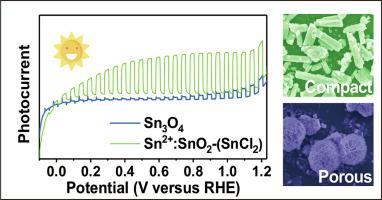Journal of Energy Chemistry ( IF 14.0 ) Pub Date : 2020-08-27 , DOI: 10.1016/j.jechem.2020.08.027 Yalong Zou , Deyu Liu , Xiangrui Meng , Qitao Liu , Yang Zhou , Jianming Li , Zhiying Zhao , Ding Chen , Yongbo Kuang

|
Photoelectrocatalytic (PEC) materials for harvesting solar energy can be discovered from existing photocatalytic semiconductors. Nonetheless, mixed valence tin oxides, a group of widely reported visible light active photocatalysts, can hardly be developed into efficient PEC photoelectrodes. To overcome this difficulty by clarifying its origin, two typical mixed valence tin oxides, Sn2+:SnO2 microrods and porous Sn3O4 particles were deliberately prepared as the models. Sn2+:SnO2 microrods of less porosity exhibited a photocurrent over ten times higher than Sn3O4 particles. Photo-electrochemical impedance spectroscopy revealed this was due to their charge kinetics difference, specifically the internal transport/transfer responding to the morphology. Moreover, hydroxyl residuals from synthesis were found to be very inhibitive for the PEC efficiency as well, which was in coherence with our TGA and Raman spectroscopic study. These finding experimentally proved the necessity of reconsidering the surface area, crystallinity, and defects when developing photocatalysts into efficient PEC structures.
中文翻译:

混合价氧化锡在光电化学中的结构限制因素:比较探索
可以从现有的光催化半导体中发现用于收集太阳能的光电催化(PEC)材料。然而,混合价的氧化锡,一组广泛报道的可见光活性光催化剂,几乎不能发展成为有效的PEC光电极。为了通过澄清其来源来克服该困难,特意制备了两种典型的混合价锡氧化物Sn 2+:SnO 2微棒和多孔Sn 3 O 4颗粒作为模型。孔隙率较小的Sn 2+:SnO 2微棒的光电流是Sn 3 O 4的十倍以上粒子。光电阻抗谱表明,这是由于它们的电荷动力学差异,特别是内部迁移/转移对形态的响应。而且,发现合成中的羟基残留物也对PEC效率有很大的抑制作用,这与我们的TGA和拉曼光谱研究一致。这些发现实验证明了在将光催化剂发展为有效的PEC结构时必须重新考虑表面积,结晶度和缺陷的必要性。











































 京公网安备 11010802027423号
京公网安备 11010802027423号